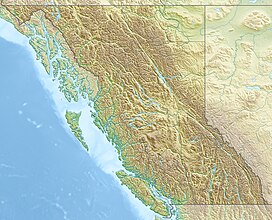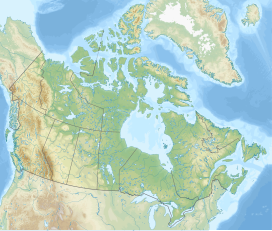geo.wikisort.org - Mountains
Limestone Peak is a 2,878-metre (9,442-foot) mountain summit located in British Columbia, Canada.
| Limestone Peak | |
|---|---|
 North aspect, with Helmet Falls to right | |
| Highest point | |
| Elevation | 2,878 m (9,442 ft)[1] [2] |
| Prominence | 51 m (167 ft)[3] |
| Isolation | 1.57 km (0.98 mi)[3] |
| Listing | Mountains of British Columbia |
| Coordinates | 51°11′00″N 116°17′53″W[4] |
| Geography | |
| Location | Kootenay National Park British Columbia, Canada |
| District | Kootenay Land District |
| Parent range | Vermilion Range Canadian Rockies |
| Topo map | NTS 82N1 Mount Goodsir |
| Geology | |
| Age of rock | Cambrian[5] |
| Type of rock | Ottertail Limestone[5] |
Description
Limestone Peak is situated on the western boundary of Kootenay National Park at the northern end of the Vermilion Range, which is a sub-range of the Canadian Rockies. The peak also anchors the northern end of what is known as the Rockwall which is an escarpment of the Vermilion Range. The Rockwall Trail is a scenic 55 kilometer (34 mile) traverse of alpine passes, subalpine meadows, hanging glaciers, and limestone cliffs, in some places in excess of 900 m (2,953 ft) above the trail.[6] Helmet Falls, located one kilometer west of the peak, is another scenic feature of the Rockwall area. Neighbors include Mount Goodsir eight kilometers to the west-northwest and Mount Drysdale four kilometers to the south-southeast. Precipitation runoff from the mountain drains to the Vermilion River via Helmet Creek and Ochre Creek. Topographic relief is significant as the summit rises over 1,100 meters (3,609 feet) above Helmet Creek in one kilometer (0.6 mile). Limestone Peak is composed of Ottertail limestone, a sedimentary rock laid down during the Cambrian period and pushed east and over the top of younger rock during the Laramide orogeny.[7] The mountain's toponym was officially adopted in 1952 by the Geographical Names Board of Canada.[8]
Climate
Based on the Köppen climate classification, Limestone Peak is located in a subarctic climate zone with cold, snowy winters, and mild summers.[9] Winter temperatures can drop below −20 °C with wind chill factors below −30 °C. This climate supports the Washmawapta Glacier on the peak's south slope.
See also
- Geography of British Columbia
References
- "Limestone Peak". PeakFinder.com. Retrieved 2022-10-20.
- The Canadian Alpine Journal, (2000), Alpine Club of Canada, p. 134
- Limestone Peak, Peakvisor.com
- "Limestone Peak". BC Geographical Names. Retrieved 2022-10-20.
-
Baird, David M. (1964). Kootenay National Park: Wild mountains and great valleys (PDF) (Report). Geological Survey of Canada. Miscellaneous Report 9. Retrieved 2020-01-06.
{{cite report}}: CS1 maint: url-status (link) - "Backpacking - Kootenay National Park". pc.gc.ca. Parks Canada. 2020-01-02. Retrieved 2020-01-06.
- Gadd, Ben (2008). Geology of the Rocky Mountains and Columbias.
- "Limestone Peak". Geographical Names Data Base. Natural Resources Canada. Retrieved 2022-10-20.
- Peel, M. C.; Finlayson, B. L.; McMahon, T. A. (2007). "Updated world map of the Köppen−Geiger climate classification". Hydrol. Earth Syst. Sci. 11: 1633–1644. ISSN 1027-5606.
External links
- Weather: Limestone Peak
- Parks Canada web site: Kootenay National Park
Другой контент может иметь иную лицензию. Перед использованием материалов сайта WikiSort.org внимательно изучите правила лицензирования конкретных элементов наполнения сайта.
WikiSort.org - проект по пересортировке и дополнению контента Википедии

